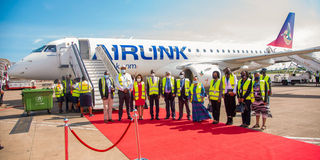Prime
Are South African businesses a pillar of Uganda’s economy?

Civil Aviation Authority and South African officials at the launch of Airlink Airlines PHOTO BY EMMANUEL KAVUMA
What you need to know:
Footprint. The influence of South African businesses in Uganda can be felt anywhere, not just in a shopping mall. From banking to retail trade, telecommunications and aviation, South African businesses have had mixed fortunes here.
When you take a stroll around any big shopping mall in Kampala city, you will notice multiple South African investments standing out.
These investments cut across sectors such as; telecommunications, breweries, banking and finance, retail, insurance and energy.
Most of these businesses have gone a long way in demonstrating good business bi-lateral relations between Uganda and South Africa.
Movement of capital from South Africa has had a huge impact on the Ugandan economy.
This perhaps can be explained by a wave of economic liberalisation programmes that swept across the African economies in the early 1990s.
It gave encouragement for these businesses to take advantage of market gaps and opportunities in an economy that was struggling to return to its feet.
The influence of a South African business in Uganda can still be felt anywhere, not just in a shopping mall.
On a hot midday afternoon of September 19th last year at Entebbe Airport, Airlink, a South African regional airline, had made its maiden flight for its Johannesburg- Entebbe service route.
In a small but heavily guarded event attended by journalists and top Ugandan and South African officials; another business partnership had been sealed between the two countries.
Airlink, though viewed as a competition to Uganda Airlines operating commercial flights on the same route, is a beneficiary of the Yamoussoukro multiple designation policy that allows more than one airline on a route and removal of frequency and capacity limitations.
The airline had entered into the footsteps of South African Airways (SAA) which exited Uganda’s aviation market in early 2020, in what it described as, “the need to restore the SAA’s commercial health and create an airline that South Africans are proud of!”
“Entebbe is not just Uganda’s primary tourism and trade route, it is also strategically positioned for access to the wider East African Community nations and the Great Lakes, which represent significant markets,” Duke Morosi, Airlink’s executive representative said in a short speech at the event.
At the same event, State Minister for Transport Fred Byamukama, who presided over the launch at Entebbe Airport, hailed Uganda’s trade ties with South Africa, which he said had, “continued to grow from strength to strength.”
“Trade relations between Uganda and South Africa continue to grow from strength to strength. South Africa has been an important source of Foreign Direct Investment (FDI) for Uganda especially in the sectors of mobile telecommunications, brewing and beverages, finance services, wholesale and retail, poultry and energy,” he added.
Byamukama noted that Uganda is currently exporting goods worth millions of dollars to South Africa including; cotton, gold, tobacco, coffee, fresh flowers among others while South African exports to Uganda include; machinery, motorcars, chemicals, electronics, textiles, footwear and household goods among others.
Away from Airlink’s launch, and back in Kampala at the MTN boardroom; another South African telecommunication business, was finalizing the listing plans at the Uganda Securities Exchange for the company’s 20 percent shares.
MTN is among the many and earliest South African businesses that have survived in Uganda’s turbulent economy.
The telecom sector in Uganda is curved out in such a way that it is duopolistic in nature; only two telecoms must thrive, and others must survive.
MTN had entered a market dominated by two telecom companies; Uganda Telecom and Celtel.
Its launch in Uganda in 1998 was confirmed with an award of an operator licence.
Mary Shirley, in her World Bank working paper writes that the license was sold through a unique bidding procedure designed to secure the government’s dual goals of a good price and rapid network and line rollout.
There was a minimum rollout of 50,000 lines, with a certain percentage to each region, set in the bidding documents. MTN won with a bid of $5.6 million for the license, US$500,000 more than the second bid, and a promised rollout of 89,000 new lines.
It was at a time the Uganda Communications Act of 1997, provided for the creation of a fund to promote rural telephony.
A universal access initiative that called for a more equitable distribution of lines across regions as an objective, as reflected in the rollout obligations in the licenses for the second national operator.
However, in less than a year, MTN had put in place a cellular network that was two-thirds the size of UTL, with 36,500 subscribers. Meanwhile, the existing cellular company, Celtel, had grown to 20,000 subscribers.
MTN had in its first year conducted an aggressive network expansion, adding value for their existing customers; most parts of the country could be reached using the MTN network at the local telephone cost.
This alone had caused some people to migrate from the Celtel network (forcing Celtel to increase the pace of their network roll-out.
MTN also appreciated the big market in SMS and introduced it ahead of its competition.
Currently, MTN has the leading market share with 15 million subscribers, and has set a pace with an investment of a billion shillings in network expansion for the next three years.
The story of South African businesses also extends into banking and finance.
In February 2002, South Africa’s Standard Group acquired 90 percent of the shareholding in Uganda Commercial Bank Limited, a government-owned bank with sixty-five branches at the time
The Group merged their new acquisition with the existing Stanbic Bank (Uganda) Limited, to form Uganda’s largest commercial bank by assets and branch network.
In November 2007, government divested its ownership in Stanbic Bank Uganda by listing its shares on the Uganda Securities Exchange. The Group also floated 10 percent of its shareholding at the same time, retaining an ownership stake of 80 percent.
The bank, which announced its latest financial results, had a final profit gain to more than 30 billion increase in 2021 compared to 2020.
Stanbic bank’s presence has given ground to other South African banks such as Absa to set up following the exit of Baclays bank in 2019.
The story is no different in the energy sector where a number of South African businesses provide energy solutions, including Eskom, the leading operator in maintenance of Uganda’s power plants.
Statistics from the Forum of South African Businesses in Uganda (FOSABU), indicate more than 70 South African companies are registered in Uganda and are estimated to have invested $2.4b (Shs 8.6 trillion) by 2015.
By 2019, the foreign direct investment figures had moved slightly higher to $3.1b (Shs 11.1 trillion).
A business expert who preferred to weigh on this matter without being quoted for conflict of interest, says South African businesses play an important role in our economy.
Two of the top five banks in Uganda are South African indicating their contribution to credit growth in the country.
In 2020 alone, the two banks lent nearly Shs 5 trillion close to 30 percent of total loans in 2020, which highlights their importance in Uganda’s economy.
In the telecom space, MTN has contributed greatly to financial inclusion with mobile money that has facilitated e-commerce and ease of transactions.
Mixed fortunes
South African businesses have had mixed fortunes in Uganda’s economy. Some have survived, while others have been forced to exit under the harsh realities of the economy.
Ramathan Ggoobi, the Ministry of Finance permanent secretary, in his analysis of the exiting trend of multinational companies indicates; in total over 21 companies have “tanked” since 2012, according to Dr Ggoobi’s assessment, with the most hit sector being retail trade (with Nakumat, Uchumi, Tuskys, Pep, Shoprite, all giving way).
In aviation (with British Airways, Etihad, Gulf all ceasing operations here) and telecoms (as evidenced by Orange, Vodafone, Smart, Africell all ceasing operations).
The other hit sectors include insurance (with AIG, Niko, Lion all out of the domestic industry); restaurants (such as Nandos and Steers which are all no more from the local market) and in banking (with Barclays being an example). In manufacturing, BAT switched its manufacturing operations to Kenya while in the oil and gas sector, Royal Shell Dutch exited Uganda.
Most of these were South African multinationals in different sectors but have since closed shop.
Ggoobi in his analysis titled: ‘Exiting Multinational Companies: Why, Impact, Remedy,’ states that Uganda is attractive, and will eventually be filled up as it has been the case with the Shoprite, a South African retail store, which has been taken over by Carrefour, a new entrant.
Despite immediate revenue and job losses, Ggoobi believes it will not be as significant as many people tend to believe, revealing that: “there are more businesses expected through different arrangements.”
An exit will always have an impact but it is more how the companies exit. The exit of Shoprite, for example, brought in a much bigger retailer Carrefour.
If Stanbic, Absa or MTN decided to exit, there will be someone else buying into the business. They have impact but they could be replaced if there is an acquisition.




